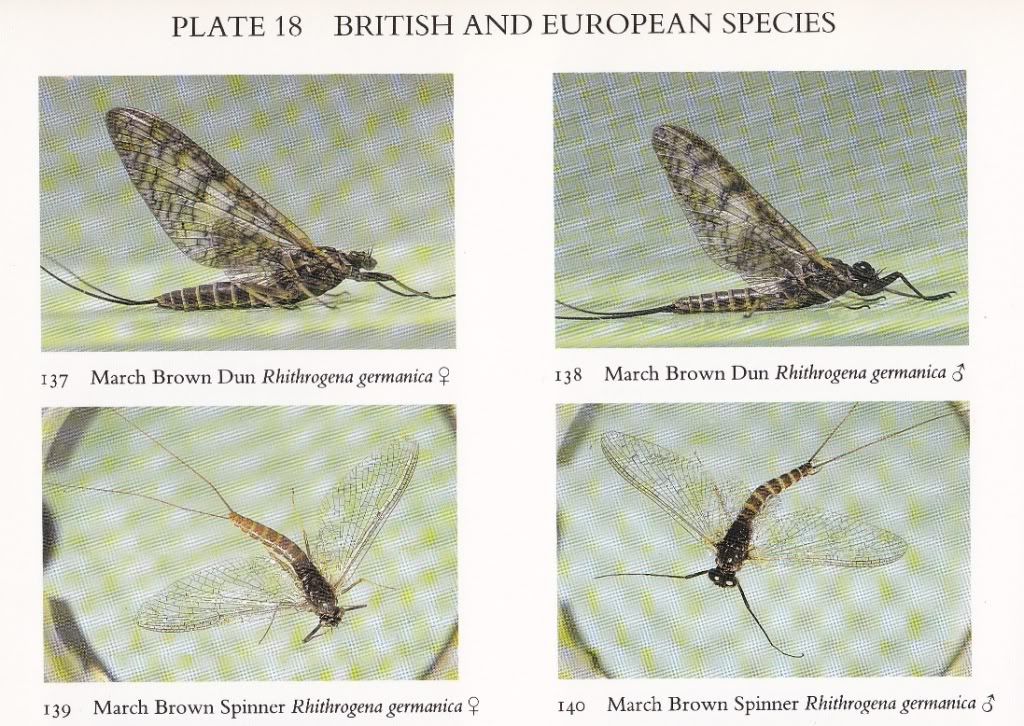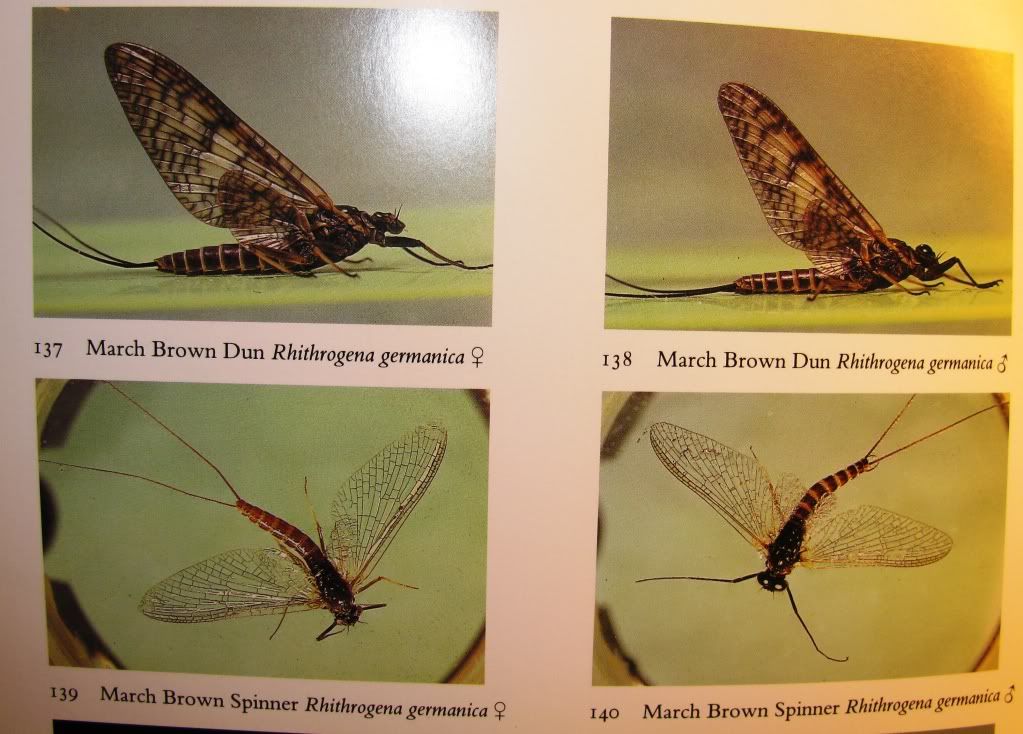March Brown design drafts
Moderators: William Anderson, letumgo
March Brown design drafts
Using a photo by Thomas Ames, I have been experimenting with a new interpretation of March Brown. If you scroll the image, you can see two drafts, and the Ames photo.
These are pretty roughly tied, as you can see, but I'm mainly trying to nail down the design right now. Once I decide on the materials and design, then I will try a thorax flymph alternate.
Both versions in this scan would probably be fishable just as they are, but I am curious to get feedback anyway, since this is such an important fly, and many of you have more experience fishing March Brown flymph variations than I do. I've seen some beautiful interpretations on Hans's site.
The main variables I'm playing with are:
dubbing colors, from creamy to red-brown, hare's cheek, rabbit and baby alpaca
hackle, two wraps ? (or three on the left-hand fly?) of pheasant hen
hackle color
tail color and length.
thread, gold and chestnut
hook, this is a 12, but will do some 10 too
So let me know if you have suggestions!
Thanks,
GingerDun
These are pretty roughly tied, as you can see, but I'm mainly trying to nail down the design right now. Once I decide on the materials and design, then I will try a thorax flymph alternate.
Both versions in this scan would probably be fishable just as they are, but I am curious to get feedback anyway, since this is such an important fly, and many of you have more experience fishing March Brown flymph variations than I do. I've seen some beautiful interpretations on Hans's site.
The main variables I'm playing with are:
dubbing colors, from creamy to red-brown, hare's cheek, rabbit and baby alpaca
hackle, two wraps ? (or three on the left-hand fly?) of pheasant hen
hackle color
tail color and length.
thread, gold and chestnut
hook, this is a 12, but will do some 10 too
So let me know if you have suggestions!
Thanks,
GingerDun
- Attachments
-
- MarchBrownDrafts1Lo.jpg (115.23 KiB) Viewed 5340 times
-
CreationBear
- Posts: 1156
- Joined: Sun Jun 20, 2010 6:35 pm
Re: March Brown design drafts
Outstanding work: what is your tailing material? (And I'm assuming a Mustad R50u hook?)
At any rate, I think the "imitationists" among us would find, well, unique color combinations depending on what they find fluttering on the water on any given river (or more likely, at different times of the year. ) Otherwise, you might try experimenting with different hackle as well--both English "moorgame" and our native red-phase ruffed grouse might shift the overall color scheme as much as a new dubbing mix.
At any rate, I think the "imitationists" among us would find, well, unique color combinations depending on what they find fluttering on the water on any given river (or more likely, at different times of the year. ) Otherwise, you might try experimenting with different hackle as well--both English "moorgame" and our native red-phase ruffed grouse might shift the overall color scheme as much as a new dubbing mix.
Re: March Brown design drafts
GingerDun
I would also consider some with a darker body than those pictured just to go with that ...mph stage of the fly/nymph struggling to the surface and not yet fully emerged as a Dun. Consider a progression with a nymph photo on the left , a darker flymph and then your 2 nice flies then the Dun (fly?). That is why we tie many soft hackles like Pheasant Tails or flymphs like the Hare's Ear to fish for March Browns.
I even tie heretical flymphs with a trailing shuck tail of Antron, Zelon or some other sparkle yarn to represent the trailing shuck of the nymph emerging or a cripple.
I would also consider some with a darker body than those pictured just to go with that ...mph stage of the fly/nymph struggling to the surface and not yet fully emerged as a Dun. Consider a progression with a nymph photo on the left , a darker flymph and then your 2 nice flies then the Dun (fly?). That is why we tie many soft hackles like Pheasant Tails or flymphs like the Hare's Ear to fish for March Browns.
I even tie heretical flymphs with a trailing shuck tail of Antron, Zelon or some other sparkle yarn to represent the trailing shuck of the nymph emerging or a cripple.
- willowhead
- Posts: 4465
- Joined: Fri Oct 29, 2010 3:35 pm
- Location: Roscoe, N.Y./Lakeview, Arkansas
- Contact:
Re: March Brown design drafts
Gorgeous tyes/flies.....both examples.....beautiful hook for that bug. i'd use a darker/brighter Orange thread/silk for the heads. It's a good trigger, and the males have Orange heads. 
Learn to see with your ears and hear with your eyes
CAUSE, it don't mean a thing, if it aint got that swing.....
http://www.pureartflytying.ning.com
CAUSE, it don't mean a thing, if it aint got that swing.....
http://www.pureartflytying.ning.com
- William Anderson
- Site Admin
- Posts: 4569
- Joined: Mon Feb 23, 2009 3:14 pm
- Location: Ashburn, VA 20148
- Contact:
Re: March Brown design drafts
GingerDun, these both exceed the design requirements to match the MB's in my opinion, but it's fun to focus on the nuances of these things. I would suggest two things. One, soak these flies in a cup and see if the markings are still as prodominant as they are when they are dry. I suspect they will be a bit more muted. CB makes a good point about hackle selection. The bodies too will blend, which is what you want, but it's something to consider up front when your putting your materials together. You might want to start with higher levels of contrast, expecting them to become more subdued when submerged. Second, the image you're using is really nice. I have seen the MB's vary quite a bit from grays and tans and yellows, so there is the stream specific effect. That being said, matching the fully hatched and dried mayfly adult is something important if you are fishing these as cripples or drowned duns, but the photos of nymphs will be much more practical in creating flymph designs.
Mark mentioned the orange eyes of the males, there are some great pics of these around that make the case for using orange silk if you're tying male duns.
I can't add much more than what Roadkill and CB have already offered. It's fun to mess about with these. Good lord, your tying is really nice. I'm loving the results your getting regarding the technique and proportions of these. Great flies.
w
Mark mentioned the orange eyes of the males, there are some great pics of these around that make the case for using orange silk if you're tying male duns.
I can't add much more than what Roadkill and CB have already offered. It's fun to mess about with these. Good lord, your tying is really nice. I'm loving the results your getting regarding the technique and proportions of these. Great flies.
w
"A man should not try to eliminate his complexes, but rather come into accord with them. They are ultimately what directs his conduct in the world." Sigmund Freud.
www.WilliamsFavorite.com
www.WilliamsFavorite.com
- letumgo
- Site Admin
- Posts: 13346
- Joined: Sat Feb 21, 2009 7:55 pm
- Location: Buffalo, New York
- Contact:
Re: March Brown design drafts
Fantastic interpretations, GD. I will pull my Ames' book when I get home and read the description to check the details for additional ideas. Do you have Ernest G. Schwiebert's two volume set called Nymphs? He has some outstanding descriptions on the color variations of various nymphs. Outstanding reference if your into insects and their behavior.
Ray (letumgo)----<°))))))><
http://www.flytyingforum.com/index.php? ... er=letumgo
"The world is perfect. Appreciate the details." - Dean
http://www.flytyingforum.com/index.php? ... er=letumgo
"The world is perfect. Appreciate the details." - Dean
Re: March Brown design drafts
Listening to you guys is like taking a college course. Can't tell you how helpful this is. Hearing how you think about the problem is priceless. I'll keep experimenting.
Some of your comments would take me in the direction of the March Brown that Pete Hidy tied.
Ginger
Some of your comments would take me in the direction of the March Brown that Pete Hidy tied.
Ginger
- Attachments
-
- PeteHidyMarchBrownLo2.jpg (63.69 KiB) Viewed 5242 times
Re: March Brown design drafts
Here is a scan of a march brown from the book of J.Goddard: Trout flies of Britain and Europe

This one is better:

Greeting

This one is better:

Greeting
There will allways be a solution.
http://www.aflyinholland.nl
http://www.aflyinholland.nl
Re: March Brown design drafts
All of these are superb.
March Browns are one of those species that really are quite different from stream to stream. Ours are very mottled, with a hint of maroon in the thorax area.
I find that most of the emerging duns are quite bulky in the thorax area so I usually put more emphasis into increasing the taper of the fly body.
Both of your examples Gingerdun are great and as William pointed out any changes would just be nit picking, but that is part of the fun anyway. I do prefer the less hackled version of the two you've shown.
March Browns are one of those species that really are quite different from stream to stream. Ours are very mottled, with a hint of maroon in the thorax area.
I find that most of the emerging duns are quite bulky in the thorax area so I usually put more emphasis into increasing the taper of the fly body.
Both of your examples Gingerdun are great and as William pointed out any changes would just be nit picking, but that is part of the fun anyway. I do prefer the less hackled version of the two you've shown.
I hate it when I think I'm buying organic vegetables, and when I get home I discover they are just regular donuts.
http://www.oldhatflytying.com
http://www.oldhatflytying.com
Re: March Brown design drafts
This is a subject that I have been interested in for a long time. Really useful pictures Ruard.
From what I have seen, American or European patterns are both useful on either side of
the Atlantic. It is a fly that seems to be influenced in it's colouring by local conditions.
I have found various Brahma hen hackles, from the saddles or sides to be good, nice
speckled hackles. I also like the Hen de Leon hackles are very good.
I was very pleased with a reverse hackle (Tenkara) pattern I dressed recently.

From what I have seen, American or European patterns are both useful on either side of
the Atlantic. It is a fly that seems to be influenced in it's colouring by local conditions.
I have found various Brahma hen hackles, from the saddles or sides to be good, nice
speckled hackles. I also like the Hen de Leon hackles are very good.
I was very pleased with a reverse hackle (Tenkara) pattern I dressed recently.

